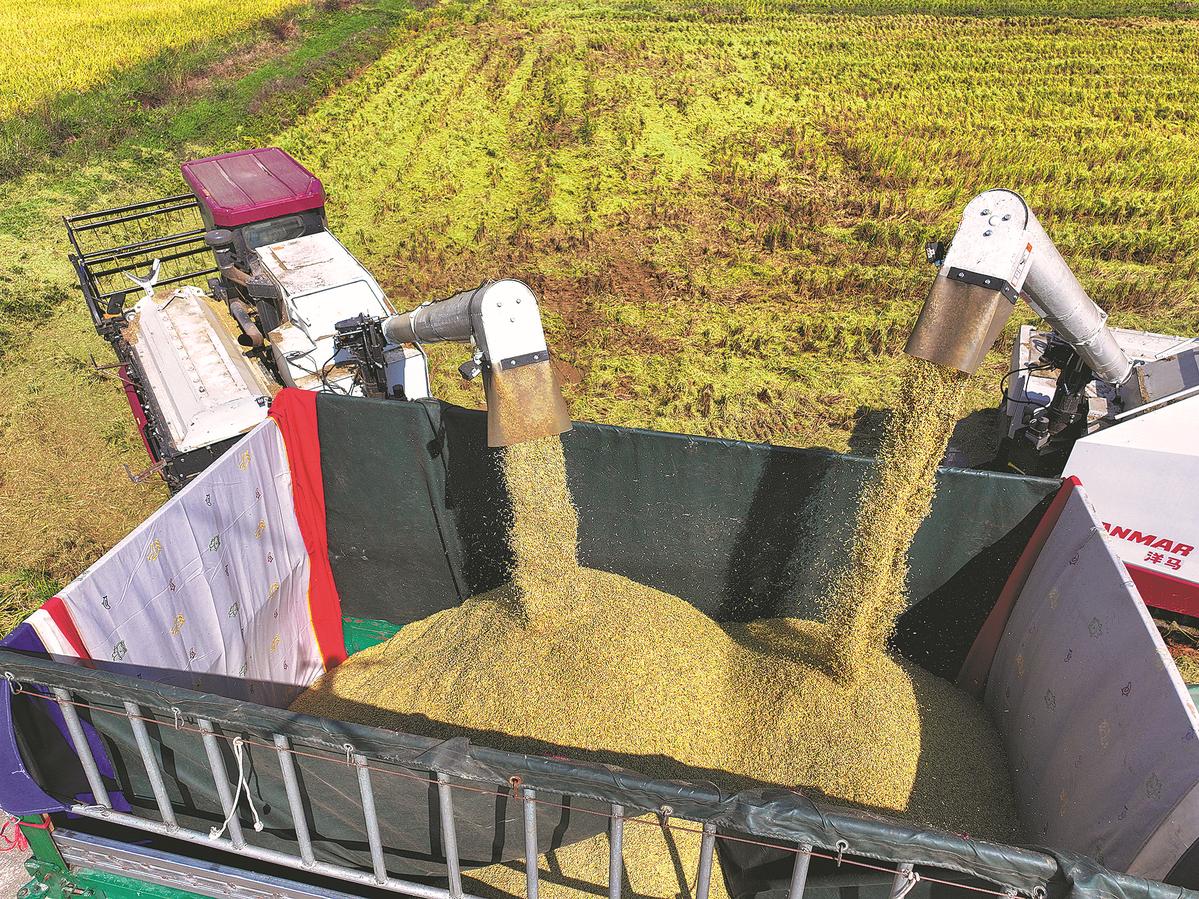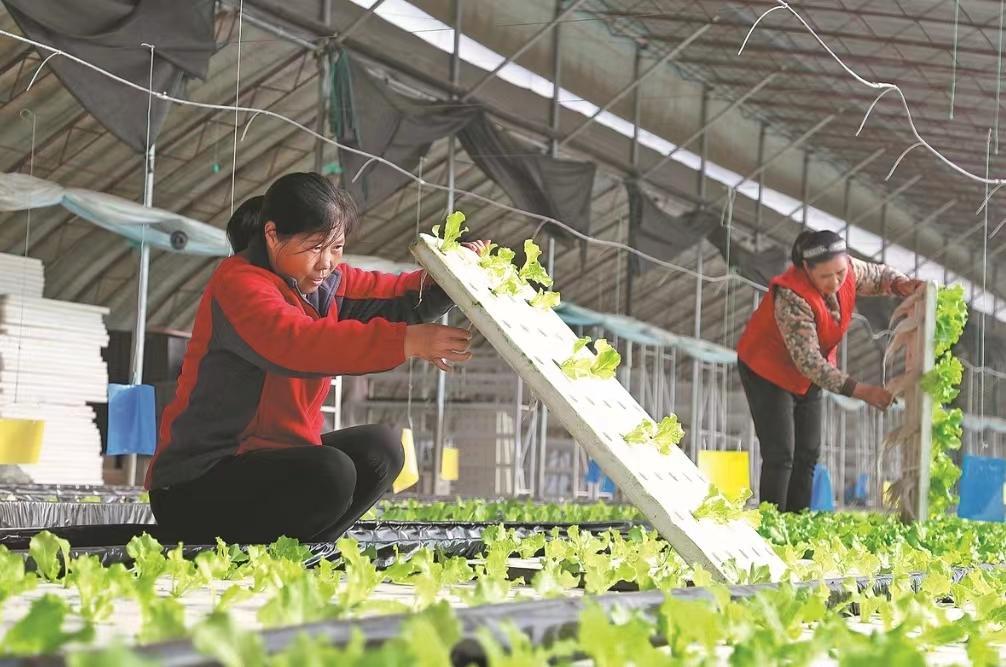China's record grain output last year was the result of efforts on multiple fronts. Li Lei reports.
A string of extreme weather events last year worried many farmers.
A cold spell in spring that affected some wheat-growing provinces was followed by record-shattering heat waves and flooding that inundated large swaths of rice fields in Northeast China. Then, an earlier-than-usual cold wave swept across much of the country in November, prompting authorities to warn vegetable growers of possible damage.
Despite the woes, the National Bureau of Statistics announced recently that China's annual grain output reached a
new high of 695.41 million metric tons last year — a year-on-year increase of about 1 percent.
It was the ninth year in a row that the grain harvest topped 650 million tons, the benchmark set by the central government to ensure national food security for roughly a fifth of the world's population.
The increase is a bright spot against the backdrop of a global rise in hunger.
On a visit to China in November, Bram Govaerts, director-general of the International Maize and Wheat Improvement Center, which is based in Mexico, described the state of global food security as scary and said the world's food supply system is fragile.
"One conflict can destabilize global wheat availability, and because of the conflict we had in one place, the world was suffering from increased wheat prices," he said, adding that countries need to revamp their food supply mix, produce more food locally and curb their reliance on imported grain — all things China has done in recent years.
Govaerts added that China's recent efforts to step up agricultural research funding were another reason the country was now more resilient when confronted with global food price increases and supply chain woes.
On multiple occasions, including before the harvest season in late October, senior Chinese agricultural officials said the greater use of high-yielding crop varieties — many also designed to thrive under extreme conditions — explained why the country's food output had remained satisfactory.
That cast a spotlight on the increasingly critical role technologies play in China's efforts to guarantee food supply as supplies of untapped arable land and other natural resources dwindle.

Harvesters load a truck with newly-harvested rice in Liuyang, Hunan province, on Nov 1. [Photo/Xinhua]
The harsh environment faced by farmers last year was noted at the annual Central Rural Work Conference in Beijing last month.
The high-level gathering reviews progress on rural-related work in the previous year — including food production — and decides priorities for the next.
It was agreed at the meeting that despite "multiple negative factors including severe natural disasters", national grain output had not suffered, rural incomes had grown more quickly, and the countryside was harmonious and stable, Xinhua News Agency reported.
The meeting also called for more breakthroughs this year using the "dual drivers of technology and reform".
China is racing to boost domestic food production and reduce its reliance on imported soybean and corn as geopolitical conflicts threaten to disrupt the global trade in food.
To shield the nation's food supply from external factors, authorities have ramped up a long-running mission to stabilize the area of farmland and have increased penalties for those repurposing it for nonagricultural use.
They also started a campaign more recently to vitalize China's sprawling but uninventive seed sector, urging plant researchers to focus on fields such as fundamental technologies, core germplasm resources and key machinery and equipment to increase agricultural efficiency.
Germplasm, the genetic resources found in things like seeds or animal tissue, is used by scientists to breed better crops or farm animals.
There have been growing calls among researchers for governments around the world to allow for unimpeded flows of such knowledge to slow the decline in crop biodiversity induced by climate change. It would also aid genetic research aimed at producing higher-yielding crop varieties able to cope with the harshest environments.
Felix Dapare Dakora, former president of the African Academy of Sciences, said during a visit to China in November that the increasing frequency of extreme weather events such as wildfires and flooding is putting the preservation of crop biodiversity under pressure, but the free exchange of germplasm could mitigate the impact.
"If we work together, we will not destroy," he said. "If we don't work together, we will destroy the planet."
China's push to bolster germplasm exchanges is part of its shift to a more technology-driven approach to addressing food security problems at home and abroad.
Sharing starts with conservation. In 2015, the agriculture ministry launched a national census of crop germplasm as part of a broader effort to rescue vanishing crop species. It involved more than 30,000 grassroots officials who collected about 12,000 germplasm samples over the course of about three years. Without that effort, there was a risk the genetic material could have become extinct.
China has also ramped up the construction of facilities to store such assets. In May, it finished a national germplasm bank for wild rice species in Sanya, Hainan province, that its builder called "the world's largest repository for gene resources of wild rice varieties".
Experts said its location, in a free trade port, helps with the sharing and use of germplasm across borders.
Three months later, the Chinese Academy of Agricultural Sciences and authorities in Beijing and Hainan launched the genome-to-phenome program, an attempt to bolster the sharing of germplasm with global partners.
The project has won widespread recognition, with Govaerts calling China a flag-bearer on that front.
"China is really getting together all the international actors," he said.
Seed research is also central to growing food in once unimaginable places such as saline-alkali land, another part of China's quest for increased food security.
Central authorities called last year for scientists and technicians to screen and nurture crop seeds that can withstand saline-alkali stress. Better seed, coupled with soil improvement methods, fertilizers and irrigation, would make a difference, they said.
In recent years, China's top legislature has formulated laws aimed at bolstering the country's seed research and development capabilities.
After three rounds of revisions since 2022, the National People's Congress Standing Committee passed the National Food Security Law late last month.

Farmers check the progress of hydroponic vegetables in Xingtai, Hebei province, on Oct 31. [Photo/Xinhua]
The 11-part law, which will come into effect in June, will give strong State backing to invigorating the seed sector and ensuring seed security.
In one part dealing with seed production, the law stipulates that the Chinese government is obliged to conserve food germplasm resources. It also says it must support efforts to commercialize next-generation breeding techniques and roll out homegrown food species that are free from the threat of embargo by agricultural powerhouses in the West.
At the NPC Standing Committee session that passed the law, China's top legislator, Zhao Leji, briefed lawmakers on the findings of a high-level inspection that was carried out from May to November last year to assess the progress in the seed sector since the Seed Law was last revised in 2022.
He listed a number of highlights in agricultural technology advancement, including the improved research prowess of seed companies, whose investment in research and development climbed to 6 billion yuan ($839 million) last year, an increase of more than 50 percent from 2015.
But he also said the supply of quality seed was inadequate and that even though the preservation of germplasm resources had been improved, efforts to use them were still lagging.
Zhao said there had been an overreliance on crossbreeding to enhance existing crop varieties, with insufficient attention paid to research powered by next-generation techniques such as gene editing and artificial intelligence, and that despite the explosive growth of seed companies since 2016, many lacked research capabilities.
That situation — coupled with a lack of knowledge transfer between companies and researchers — had hampered progress toward a market-oriented breeding environment, Zhao said, citing the example of Gansu province, where 85 percent of seed companies operated by conducting trial planting of new food varieties developed by their clients rather than designing them in-house.
"Most companies are unable to conduct R&D," he said.
Zhao reiterated China's commitment to the protection of corporate seed breeders' intellectual property rights. In the past they have had to grapple with lengthy and costly legal procedures to seek compensation when their interests have been jeopardized.
"The seed industry is one of national strategic importance," he said. "We must fully implement the Seed Law and promote the sector's vitalization with legal provisions."
(Original Title: Agricultural R&D key to food security)
Category
Agricultural Research and Development Key to Food Security
Contributor
Agricultural Research and Development Key to Food Security
Country
Technical Solutions

